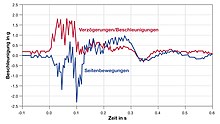

The accident data recorder (ADR, German commonly abbr.: UDS, also accident (data) writer)[1] is an independent electronic device that records before, during, and after a traffic accident relevant data and thus resembles a flight recorder.
It can be installed in motor vehicles (cars, trucks, buses, motorcycles, trams, and special vehicles) on a voluntary basis in order to obtain more accurate information about the events in an accident. In some countries there are regulations for mandatory[2] installation in different vehicles. The accident data recorder constantly records various data of the vehicle (such as speed, direction of travel, longitudinal and transverse vehicle acceleration, status of the lights, turn signals and braking, etc.) and records them for some time before they are automatically cleared.
In the case of an accident (this is detected by a strong acceleration of the vehicle as a result of an impulse), certain periods of time (usually in the two-digit seconds range) remain permanently stored before and after an event. This makes it much easier to reconstruct events after an accident, so that if necessary the question of fault can be clarified.
Many vehicles of authorities (such as police or ambulance) are equipped with them, as it often comes to assist with disputes that pertain to collisions during high priority calls as well as compliance with applicable laws and regulations. A side effect of vehicles equipped with UDS is that drivers behave more cautiously on the road.[3][4] According to a survey by the EU Transport Commission, UDS users experienced a 20 to 30 percent decline in traffic accidents.[5]
The accident data recorder is often used by experts or institutions in crash tests as a measuring device.[6]


The installation (also later) costs about 700 euros[7] and can lead to a deduction for some insurance policies. The accident data recorder can be read by an expert via interface cable. The accident data recorder (older generations) has a switch with which the driver can delete the stored data immediately after an accident so as not to burden himself with the later question of guilt. However, this feature may be disabled, for example for use in company vehicles.[8]
- ^ Wolfgang Hugemann, Karl-Heinz Schimmelpfennig (1992), "Der Unfallschreiber - Funktionsprinzipien, Genauigkeit, Auswirkung auf die Tätigkeit des Sachverständigen", VKU Verkehrsunfall und Fahrzeugtechnik (in German), vol. 30, no. 2, pp. 49–59
- ^ "Art. 102 Datenaufzeichnungsgerät (Verordnung über die technischen Anforderungen an Strassenfahrzeuge (VTS) in der Schweiz)". Retrieved 2018-09-21.
- ^ Dirk-Antonio Harms (27 February 2003). "Unfalldatenspeicher (UDS) als möglicher Beitrag zur Verkehrssicherheit im Meinungsbild Jugendlicher und Heranwachsender (Seite 48)". D-nb.info. Retrieved 2016-04-20.
- ^ "Goslar Institut - der Unfalldatenspeicher ist wohl nur eine Frage der Zeit - MotorZeitung.de".
- ^ Robert Dunker (27 August 2012). "ADAC warnt vor der Blackbox fürs Auto". Die Welt. PS Welt. Retrieved 2018-09-22.
- ^ Alexander Wiek (1999), "Die UDS-Plattform – Ein Hilfsmittel zur schnellen und einfachen Anwendbarkeit des UDS von VDO-Kienzle als Messgerät für den Sachverständigen", VKU Verkehrsunfall und Fahrzeugtechnik (in German), vol. 37, no. 9, pp. 237–239
- ^ "Datenspeicher verbessert Unfall-Rekonstruktion". Handelsblatt. 2004-10-20. Retrieved 2018-10-01.
- ^ Dirk-Antonio Harms (27 February 2003). "Unfalldatenspeicher (UDS) als möglicher Beitrag zur Verkehrssicherheit im Meinungsbild Jugendlicher und Heranwachsender (Abschnitt 3.9 UDS bei WKD Security, Seite 51)". D-nb.info. Retrieved 2016-04-20.